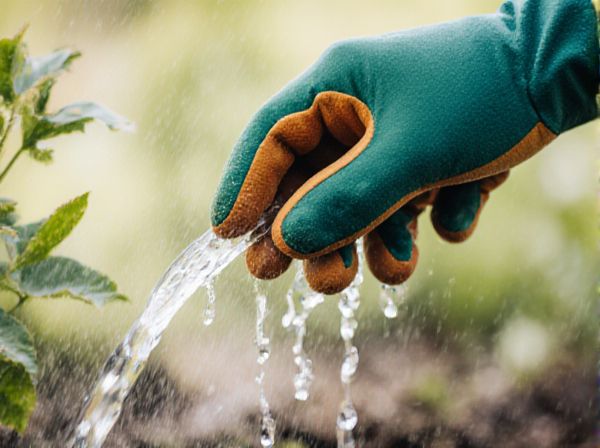
Bottom Watering vs Overhead Watering Illustration
Bottom watering delivers water directly to plant roots by allowing soil to absorb moisture from below, promoting healthier growth and reducing leaf diseases. Overhead watering mimics natural rain but can lead to fungal infections and water waste due to evaporation. Choosing bottom watering enhances water efficiency and plant health, especially in greenhouse environments.
Table of Comparison
| Feature | Bottom Watering | Overhead Watering |
|---|---|---|
| Water Delivery | Water absorbed through drainage holes | Water sprayed directly onto leaves and soil |
| Moisture Control | Precise, reduces overwatering risk | Less control, risk of runoff and puddling |
| Plant Health | Minimizes fungal diseases, promotes strong root growth | Can cause leaf diseases, may stress plants |
| Labor Intensity | More time-consuming setup, less frequent watering | Quick and easy application |
| Water Efficiency | High efficiency, reduces evaporation | Lower efficiency, higher water loss |
| Suitability | Best for sensitive plants and seedlings | Ideal for large areas and mature plants |
Understanding Bottom Watering and Overhead Watering
Bottom watering delivers moisture directly to the plant roots by allowing water to soak upward through drainage holes, promoting deep root growth and reducing leaf diseases caused by wet foliage. Overhead watering mimics natural rainfall, evenly distributing water over the plant surface and soil but can increase the risk of fungal infections and water runoff if applied excessively. Choosing between bottom and overhead watering depends on plant species, greenhouse conditions, and the goal of minimizing water waste while ensuring optimal hydration.
How Bottom Watering Works in Greenhouses
Bottom watering in greenhouses involves supplying water directly to the plant roots through the drainage holes at the base of pots or containers, ensuring consistent moisture without wetting the foliage. This method minimizes the risk of fungal diseases and promotes deeper root growth by encouraging plants to absorb water from the bottom. Efficient bottom watering systems, such as capillary mats or sub-irrigation trays, enhance water conservation and improve overall plant health in controlled greenhouse environments.
Benefits of Overhead Watering Systems
Overhead watering systems provide uniform moisture distribution, ensuring consistent hydration across greenhouse plants and reducing the risk of dry spots. They help maintain optimal humidity levels, which benefits plant growth and minimizes pest infestations. These systems are efficient for large-scale operations, saving time and labor compared to manual watering methods.
Water Efficiency: Bottom vs Overhead Methods
Bottom watering delivers moisture directly to the plant roots through capillary action, significantly reducing water evaporation compared to overhead watering. Overhead watering often results in water loss due to runoff and evaporation, making it less water-efficient in greenhouse environments. Implementing bottom watering can enhance water conservation by up to 30%, optimizing irrigation efficiency for greenhouse crops.
Impact on Plant Health and Root Development
Bottom watering promotes deeper root growth by encouraging roots to grow downward in search of water, reducing the risk of fungal diseases caused by wet foliage. Overhead watering can lead to water sitting on leaves, increasing susceptibility to mold, mildew, and other pathogens while potentially causing uneven soil moisture. Consistent moisture from bottom watering supports robust root systems and healthier plants in greenhouse environments.
Common Challenges with Each Watering Method
Bottom watering in greenhouses often faces challenges such as uneven moisture distribution and potential root rot from waterlogged soil, while overhead watering can lead to leaf diseases due to prolonged wet foliage and increased evaporation loss. Both methods require careful monitoring to maintain optimal humidity levels and prevent nutrient leaching, which can affect plant health and growth. Efficient water management systems and timing adjustments are crucial to mitigate these issues and promote sustainable greenhouse cultivation.
Greenhouse Equipment for Bottom and Overhead Watering
Greenhouse equipment for bottom watering includes capillary mats, ebb and flow trays, and sub-irrigation systems that ensure consistent moisture delivery directly to plant roots, reducing water waste and fungal issues. Overhead watering systems, such as misting systems, sprayers, and adjustable irrigation nozzles, provide widespread coverage and humidity control essential for seedling and foliar applications. Selecting appropriate equipment depends on crop type, greenhouse size, and irrigation efficiency requirements to optimize plant health and resource use.
Best Plants for Bottom Watering vs Overhead Watering
Bottom watering is ideal for plants with delicate leaves, such as African violets and ferns, as it prevents water from sitting on foliage and causing fungal diseases. Overhead watering suits tough-leaved plants like tomatoes and peppers because it mimics natural rainfall and helps wash away dust and pests. Succulents and cacti benefit most from bottom watering to avoid rot, while leafy greens thrive with consistent overhead watering to maintain leaf hydration.
Maintenance Tips for Greenhouse Watering Systems
Bottom watering minimizes leaf wetness, reducing fungal diseases, while overhead watering can promote quicker plant hydration but requires careful spray timing to avoid mold. Regularly clean and inspect watering nozzles or trays to prevent clogs and algae buildup. Implementing timers and moisture sensors ensures consistent water delivery, optimizing plant health and conserving resources.
Choosing the Right Watering Method for Your Greenhouse
Bottom watering promotes healthier root development by allowing plants to absorb water directly from the soil, reducing the risk of fungal diseases common with overhead watering. Overhead watering can efficiently hydrate larger areas but may increase humidity and encourage mold growth in greenhouse environments. Selecting the appropriate method depends on plant species, soil type, and greenhouse humidity levels to optimize growth and prevent disease.
Bottom Watering vs Overhead Watering Infographic

 gardendif.com
gardendif.com